This is the 32nd in a series of posts on the Fujifilm GFX-50S. The series starts here.
There have been conflicting reports about whether the Fujifilm GFX 50S focuses at taking aperture or not. It’s an important question, because, as we’ve seen in the last post, the 63 mm f/2.8 lens has a moderate amount of focus shift, and should be focused at the taking aperture in situations where image sharpness at the focus point is critical. It sure looks like it’s stopping down to focus when you peer into the lens while firing off frames, but it all happens so fast that you may just be looking at the lens stopping down after it achieves focus.
I’m not going to bury the lede, here. With the 63 mm f/2.8 lens attached, the GFX does not achieve critical focus anywhere near constantly at f/4 and f/5.6, and even f/8 is a little dodgy.
I’ll show you the chart with the smoking gun first, explain it a bit, and then go into painful detail about how it was generated for those of you who either care about such things in the abstract, or need to know what I did to replicate it or find out if it passes your personal muster.
Here’s the chart:
What you are looking at is a standard measure of sharpness, MTF50, as measured in cycles per picture height (cy/ph) at the whole stops from f/2.8 through f/16. The orange line is the average, or mean, of the 41 exposures at each aperture. The gray line is that average, plus the standard deviation for the 41 exposures, and the blue line is the average minus that standard deviation. If the data were Gaussian (which it isn’t) two thirds of the values would be between the gray and the blue lines.
A word about the processing. The images were developed in Lightroom with default settings except for white balance, which was set to the target white with the eye dropper. Since the Lightroom default setting includes some sharpening, these numbers are higher than the raw channel numbers that I have posted earlier. For now, you should compare these numbers only to the other ones in this test.
The f/2.8 distribution is nice and tight. I haven’t tried yet, but I don’t think I could do that well with manual focus. However, the f/4 and f/5.6 distributions are by comparison pretty sloppy. Not only that, but the averages for those two stops are lower than the average for f/2.8. That’s not the way it should be. We have seen from the previous tests that the 63/2.8 lens is sharper at f/4 and f/5.6 than it is wide open.
I need to but this behavior into context. I’ve never tested an autofocus lens/camera system that is anywhere near as sharp as the GFX and the 63 mm lens. The sharper the imaging system, the more difficult is is to achieve a focus that gets the most out of it. SO I don’t know if there si a higher quality alternative available. This is making me want to test the X1D.
At f/8, the spread is tightening up. That doesn’t necessarily mean that the AF is getting more accurate; it could be — and probably is — that he depth of filed is starting to make the foucs accuracy less important. That is proably also the explanation for the nice tight spreads at f/11 and f/16.
The average at f/4 and f/5.6 is not only lower than that at f/2.8, it is lower than that at f/8, where diffraction is holding down the on-axis sharpness. Thus, I think it’s safe to say that the lens is not achieving critical focus at f/4 and f/5.6. That makes me ask myself if it’s actually focusing at the taking aperture for those two stops. But the more important thing is that is does not seem to be constantly focusing in the same place.
Let me be clear that the average at any aperture never drops below 2000 cy/ph, and 2000 cy/ph is exceedingly sharp. I’m not saying that any of these sets of readings means that the camera’s AF system delivers fuzzy images: just not as sharp as they should be.
If we look just at one of the green raw channels we see roughly the same thing:
The numbers are slightly higher even though Lightroom sharpens during demosaicing.
Here’s the raw data for the Gr channel:
You’ll note that f/5.6 produces some sharp and some not-so-sharp results, depending on the luck of the draw.
Test conditions:
- ISO 100.
- 5000K illumination, bright enough so that the f/2.8 exposure was 1/320 second
- Target distance 3 meters
- AF focus/release/priority: focus
- Rapid AF: off
- Pre-AF: off
- AF-S
- 117 AF point mode, center point chosen, default size.
- EFCS on
- Pre-release half-shutter depression time: 750 milliseconds
- Shutter release full depression time: 250 milliseconds
- Camera moved 4 mm between exposures over a total range of 0 to 160 mm (40 moves, 41 exposures per stop)
- Camera motion applied by Cognisys focusing rail, with 1250 msec post-move settle time
- Shutter timing does by the same Cognisys controller
- RRS heavy-duty legs
- Arca-Swiss C1 head
The target was selected to be easy to focus on:
The above data is not the first series of test images that I made. Initially I made images with alternating 500-millisecond half presses and no half presses at all, with the camera set to release priority.
It’s clear from the above curve that 500 msec with release priority is not long enough ath f/8 and f/11. Interestingly enough, the results at f/4 and f/5.6 don’t seem to have been adversely affected.
With no half-press at all, just an (electronic) mashing of the shutter release:
That’s even worse.
I don’t normally show raw data, but the sequence of 500-msec half press exposures in instructive:
I’ve circled in red the points that I’d like to call to your attention. They are the f/4 and f/5.6 results that are high. It may be that the average is being dragged down not by a systematic focusing at the wrong f-stop, but by random focusing errors.
This next graph is the raw data from the 750 msec, focus priorit series with which I led off:
It’s hard to say, but looking at this graph makes me think that there is some systemic source of error, since there are hardly any f/4 or f/5.6 poits as high as the bulk of the f/2.8 ones. You can also see that both f/4 and f/5.6 have some quite low values.
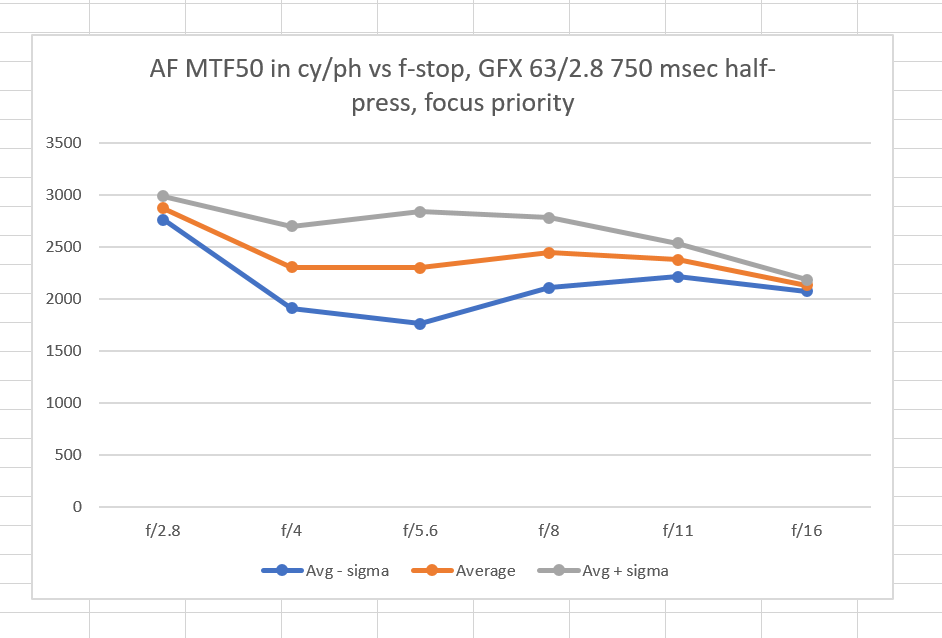
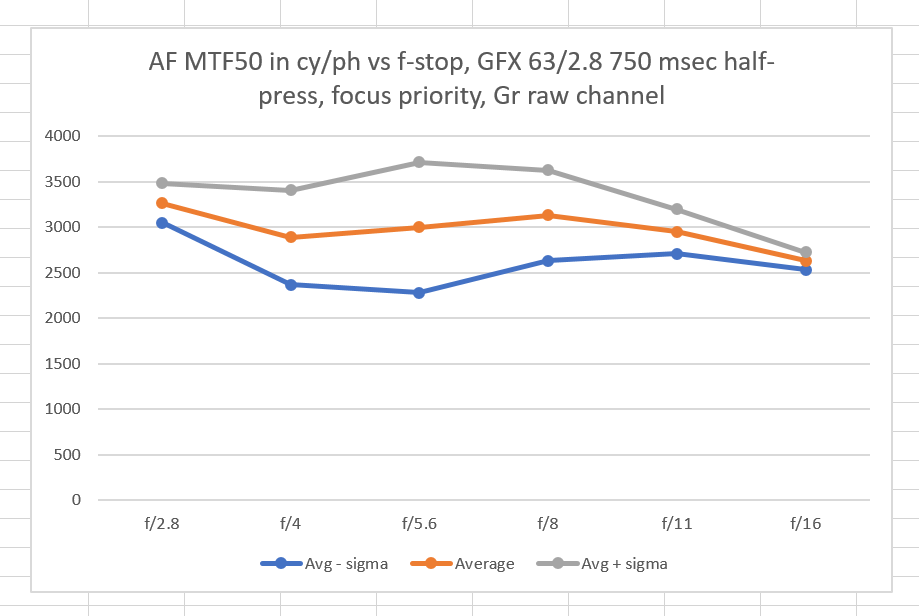
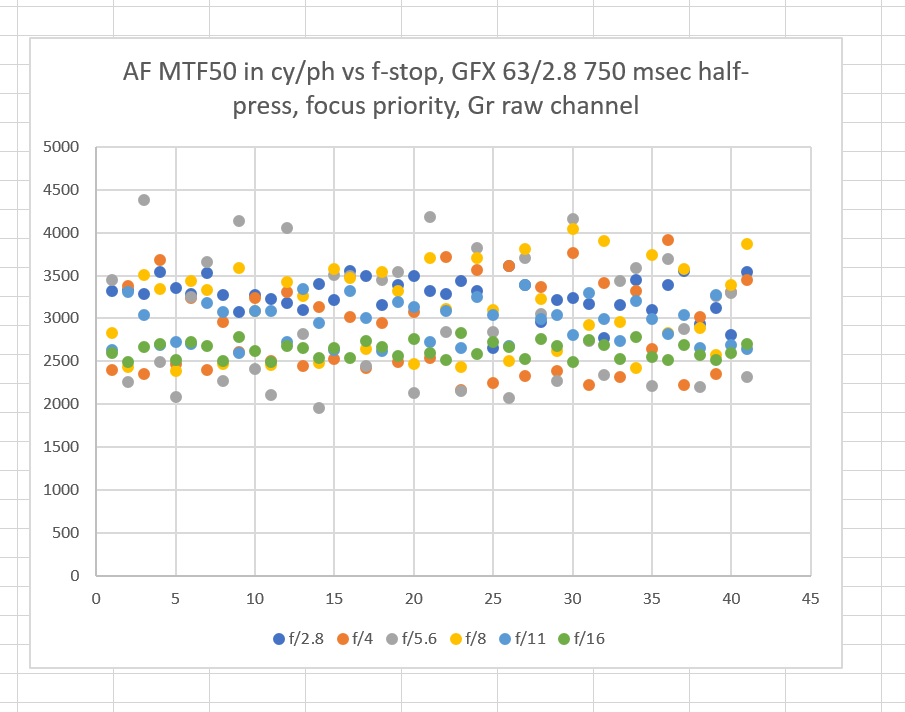
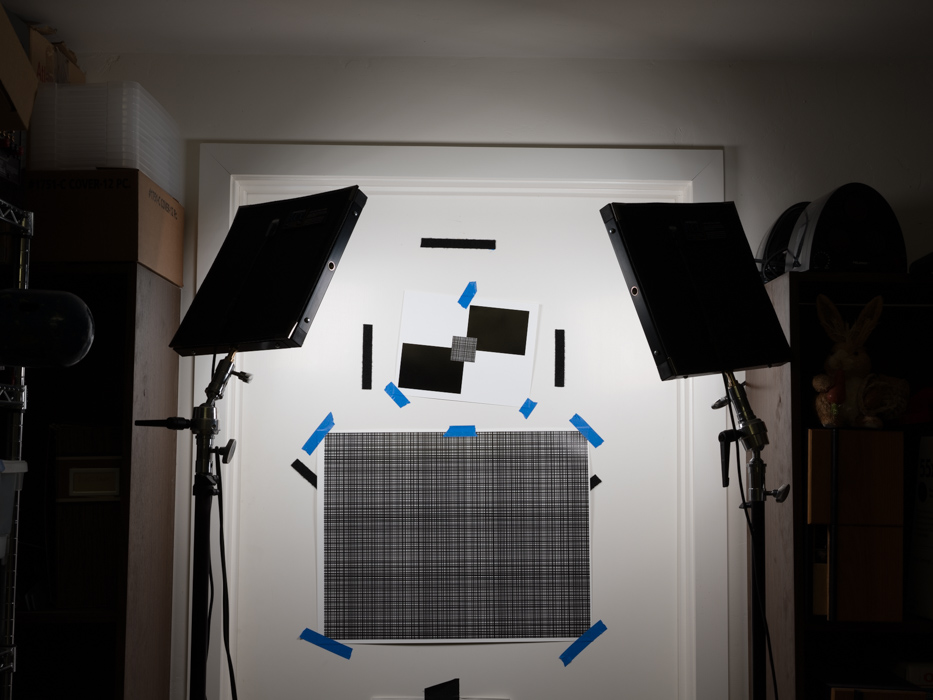
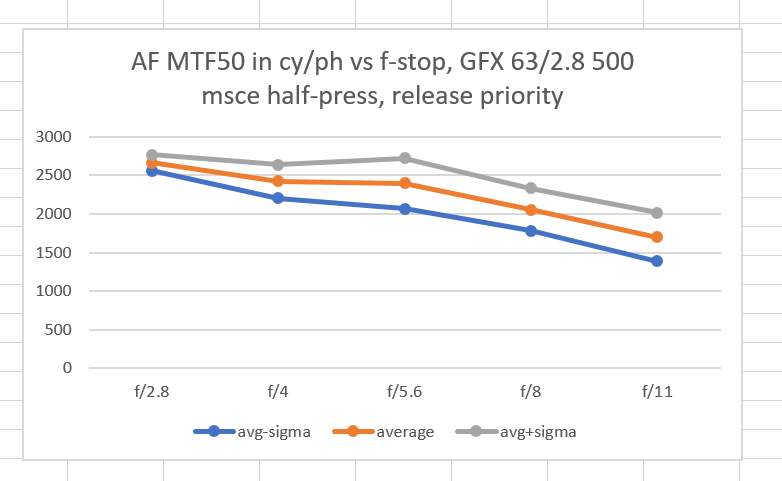
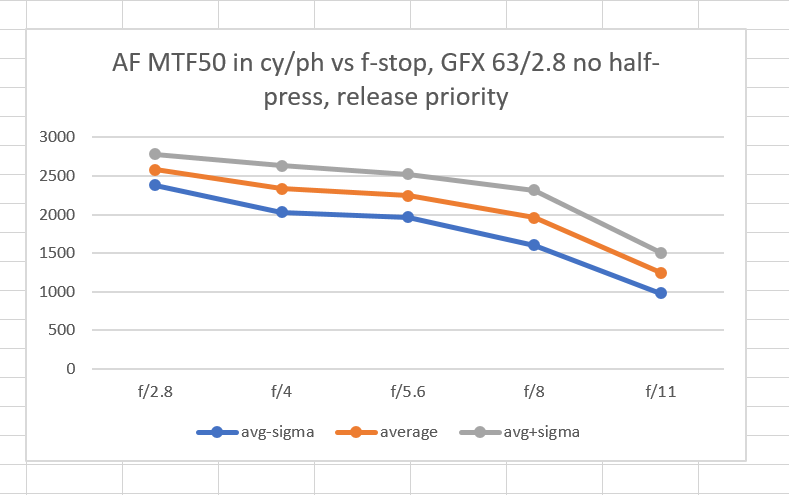
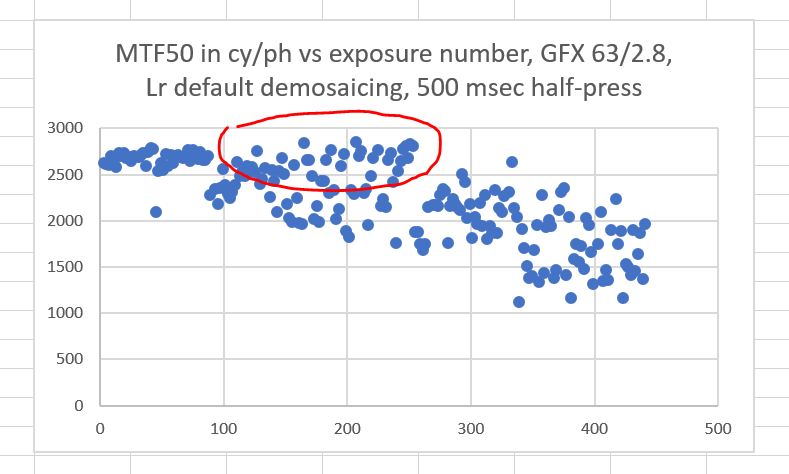
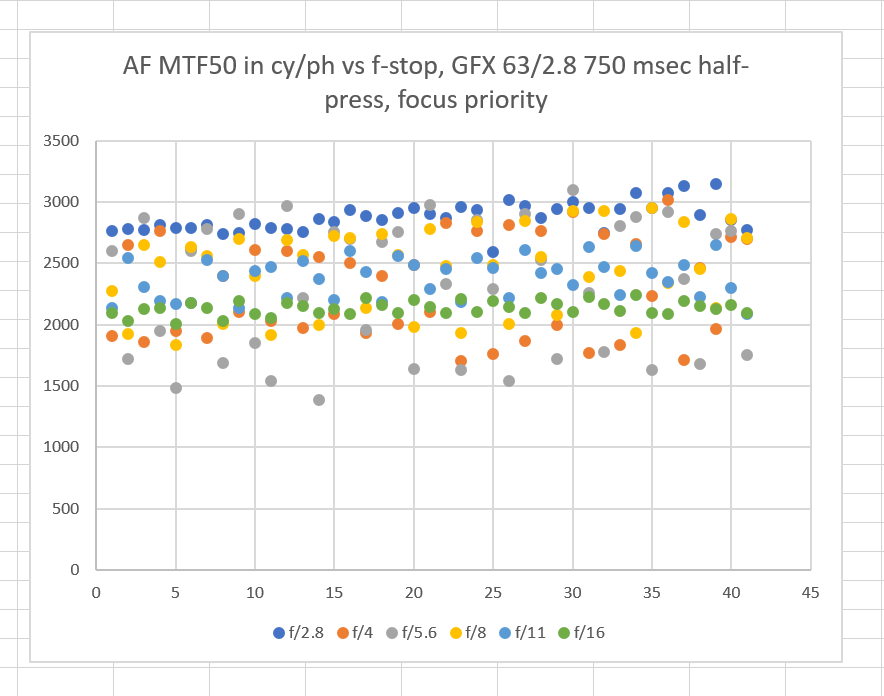
Michele Barana says
Hello Jim,
did you take the pictures in Aperture Priority mode? After reading your first article on focus shift and the Fuji focusing wide open and stopping down before exposure, as soon as I got the GFX I made a quick test. It looks like the Aperture Priority mode is the only one where the camera behaves this way; in Shutter Priority or Manual the lens appears to stay stopped down.
Congratulations for your terrific work, I constantly follow your blog and it amazes me every time.
Thanks,
Michele
JimK says
I did use C mode on the lens, and A on the shutter.
Erik Kaffehr says
Hi Jim,
Just an idea… Could be that it examines focus and if the algorithm finds good sharpness it just leaves it there? Once the camera has moved long enough to cause unsharpness it would seek new focus. So that would mean that say each third exposure had good focus, next exposures drop a bit.
Best regards
Erik
JimK says
That’s why I moved the camera between exposures. But that turns out to be unnecessary. The camera starts focusing from an OOF position for each exposure even if you don’t move it.
Christoph Kügler says
Hi Jim, thanks for all your efforts, great source of quantitative reliable information.
If I look at the GF 63f2.8 from the front when focussing with AF at different apertures it looks to me:
At apertures from f2.8 to f5.6, the camera closes the aperture to that value and performs the auto-focus at that f-stop as soon as the shutter is half pressed.
At apertures smaller than f5.6, the aperture is first closed to that particular value, so one sees in life-view the world at that chosen aperture but as soon as the shutter is pressed half to focus, the aperture opens to f5.6 (that means auto-focus is carried out at f5.6), as soon as the shutter is fully pressed for the exposure, the aperture is closed to the first value.
Is that your finding too?
That might not be an explanation for the inconsistent af precision result at apertures around f4 to f5.6 but maybe a hint.
Christoph Kügler says
I also will do some simple af tests at different apertures with an angled piece of paper with text, let’s see …
Christoph Kügler says
Carrying out my test I see one thing: I have no sturdy tripod at hand and the af of the 63 moving the whole front lens group out and in moves the whole camera on the tripod a mm or so back and forth. So I am wondering if the camera has any chance to focus perfectly that way.
JimK says
I’m doing my testing a a set of the biggest, stiffest RRS legs there are, so I don’t think that tripod motion is a problem. If it were, wouldn’t the f/2.8 results be inconsistent as well?
Jack Hogan says
Jim, are shutter speeds at f/4 and f/5.6 1/160s and 1/80s resp? If so those are in the camera-shake danger zone, any chance of any of that?
JimK says
Jack, I’m using EFCS, so the “danger zone” doesn’t apply. Also, these are the same shutter speeds I used for the razor blade tests with the motorized rail, and there was no problem there.